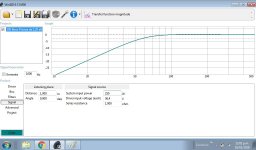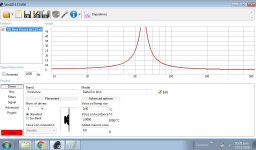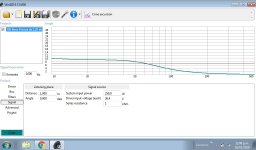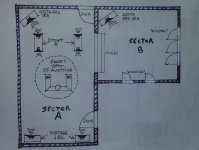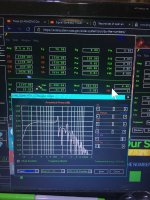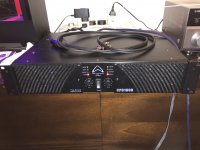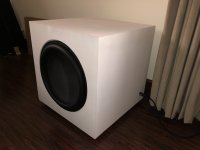The subwoofers need more power than the rest of the spectrum. (the first two octaves, 20 to 80 hz)If you simulate your speaker you will get a rough idea of how much power it takes
to get to 90 dB.
Assuming you listen around 87 to 92 dB maybe Max 94 to 96 dB
likely wont need much more than 60 to 120 watts
For clean stable power with overhead , 250 watts is enough
500 watts more than plenty
The working range of the subwoofer is very demanding, 60 or 120 watts will only tickle that Ultimax speaker.
The more power, the better.
The simulation shows that.
The following graph corresponds to the sealed cabinet ( prism ) that I built, they areThe subwoofers need more power than the rest of the spectrum. (the first two octaves, 20 to 80 hz)
The working range of the subwoofer is very demanding, 60 or 120 watts will only tickle that Ultimax speaker.
The more power, the better.
The simulation shows that.
150 litres.
Speaker: Eminence Delta Pro 18A
You can see how the generated Spl (at 1M) drops off sharply from 80hz even though we are applying 250 Watts.
The Dayton Ultimax will have less drop (slightly more SPL in low frequencies), but if you want to "flatten" the curve there are only two solutions (with considerable powers, minimum half the RMS power that the speaker admits to obtain good results) :
Use DSP
Build a huge BR cabinet
Attachments
Please remember room gain typically helps a lot below 40Hz, and typical room modes... In-room large sealed woofer(s) easily give nice flat response down to 20Hz with minimal boost. If one likes, then add high shelf around 100Hz and that's it, or with 4-way just add gain to subwoofer amp.
https://www.svsound.com/blogs/subwoofer-setup-and-tuning/what-is-subwoofer-room-gain

https://www.svsound.com/blogs/subwoofer-setup-and-tuning/what-is-subwoofer-room-gain
Yes, the graph looks almost "flat" up to 10 Hz. Fantastic!
But the room gain in large rooms is not that much and there are also other problems, which are explained in the same article.
The OP has not mentioned the size of the room, in my case, I have a medium room and open in its longest dimension to another adjoining room, I found 70 watts in two BR cabinets insufficient. I did not do too many tests with the location, due to the impossibility of moving the furniture, etc. So I opted for two sealed in two separate corners of each room. Null points disappeared.
But, at high SPL, the speaker bottomed out (an old JBL) so I went for the sealed ones I mentioned and a Dayton without DSP. 250 Watt mono. But I was not satisfied and went for the stereo, 450 Watts per channel....
But, it's my personal experience, I don't think it's the same as anyone else's because of the atypical room.
But the room gain in large rooms is not that much and there are also other problems, which are explained in the same article.
The OP has not mentioned the size of the room, in my case, I have a medium room and open in its longest dimension to another adjoining room, I found 70 watts in two BR cabinets insufficient. I did not do too many tests with the location, due to the impossibility of moving the furniture, etc. So I opted for two sealed in two separate corners of each room. Null points disappeared.
But, at high SPL, the speaker bottomed out (an old JBL) so I went for the sealed ones I mentioned and a Dayton without DSP. 250 Watt mono. But I was not satisfied and went for the stereo, 450 Watts per channel....
But, it's my personal experience, I don't think it's the same as anyone else's because of the atypical room.
Last edited:
GM can attest to the time it took me to build the sub corners, he has given me a lot of good advice, he has a lot of knowledge and experience, maybe he can add something to the OP...... 😉
GM
I have opened a new thread here, I think you will like it.
https://www.diyaudio.com/community/threads/altec-lansing-in-immaculate-condition.382954/
I have opened a new thread here, I think you will like it.
https://www.diyaudio.com/community/threads/altec-lansing-in-immaculate-condition.382954/
Yeah I pretty familiar with the Delta Pro and Sigma Pro.
pro sound 18"
Not mechanical designed to be optimal in sealed configuration. And Xmax is not much more than 6mm
Larger boxes they just hit excursion limit, And a large BR means its unloading around 250 watts.
Appling EQ to get more bass to that impedance curve just dont work.
F3 wont be much more than 50 or 45 Hz. With live sound and just simple reflex cabinets.
The Delta and sigma doesn't mean more bass. They just sound better and more accurate than a 15"
since the reflex wont be 50hz like a 15 it will be 30 hz. But F3 is still around 50/45hz
its just slightly more accurate than a 15"
No offense but we are dealing with a completely different animal with the Dayton UM
Its a well loved driver because it is a 22mm coil not a 6mm coil driver.
And its more ideal in a large sealed cabinet, not a reflex.
Bass is incredible accurate down to 25/30 hz sealed, and since it wont unload sealed.
You can add further EQ.
Not interested in arguing.
The proposed set up the OP asked about will be very nice.
The Dayton UM18 does extremely well in .8 to .7 Qtc SEALED CABINET
around 8 to 10 cubic feet
And the DSP amplifier he is asking about will allow easy to
dial in level control and filters. 500 watts is plenty of power.
pro sound 18"
Not mechanical designed to be optimal in sealed configuration. And Xmax is not much more than 6mm
Larger boxes they just hit excursion limit, And a large BR means its unloading around 250 watts.
Appling EQ to get more bass to that impedance curve just dont work.
F3 wont be much more than 50 or 45 Hz. With live sound and just simple reflex cabinets.
The Delta and sigma doesn't mean more bass. They just sound better and more accurate than a 15"
since the reflex wont be 50hz like a 15 it will be 30 hz. But F3 is still around 50/45hz
its just slightly more accurate than a 15"
No offense but we are dealing with a completely different animal with the Dayton UM
Its a well loved driver because it is a 22mm coil not a 6mm coil driver.
And its more ideal in a large sealed cabinet, not a reflex.
Bass is incredible accurate down to 25/30 hz sealed, and since it wont unload sealed.
You can add further EQ.
Not interested in arguing.
The proposed set up the OP asked about will be very nice.
The Dayton UM18 does extremely well in .8 to .7 Qtc SEALED CABINET
around 8 to 10 cubic feet
And the DSP amplifier he is asking about will allow easy to
dial in level control and filters. 500 watts is plenty of power.
Understanding what you say and in general I agree, I will only make a few observations. I already said that I do not intend to evangelize here.
8 to 10 cubic feet is 226/283 liters, doesn't seem ideal for a home cabinet, at least in a cube shape. (that's why I chose a prism design)
Regarding the impedance curve, the Bheringher NX3000D incorporates an impedance compensation circuit. Likewise, with the 250 Watts class AB Dayton and linear source, I did not notice any distortion or clipping either, it comfortably handled the Delta Pro A impedance curve.
With DSP, I apply a boost below F3 (there are several types of curves available, I stayed with Bessel 18 DB/octave) I have tested with a pure tone of 20hz, and also connecting and disconnecting the subwoofers while playing music, ( not necessarily with deep bass ) and well, Bach's Tocatta and Fugue doesn't shake or shake the chest - it depends on the volume - but my ears are happy with what they perceive at normal listening levels as the OP clarifies.
6.7 mm of Xmax is enough, because I don't get to exceed that limit, I have two speakers, it's 3 DB extra without calculating the room gain, and if it did, Xmech is 15 mm.
So, in my case, with my speakers, my amplifier and my room, the two missing octaves are amply covered, I don't need to see the cones move or air blowing, it's not necessary because the music we can hear starts from of 20 Hz. This is a widespread visual illusion, "Hey, look how it moves", a fad for the HT or car audio world.
500 Watts is not a lot of power, I don't see what the problem would be, on the contrary, it is welcome, the Ultimax has a sensitivity of 88.6 SPL/M, and these days class D is powerful, light and cheap. To use 100 Watts, it is not necessary to purchase a speaker designed to handle 1000 Watts RMS.
8 to 10 cubic feet is 226/283 liters, doesn't seem ideal for a home cabinet, at least in a cube shape. (that's why I chose a prism design)
Regarding the impedance curve, the Bheringher NX3000D incorporates an impedance compensation circuit. Likewise, with the 250 Watts class AB Dayton and linear source, I did not notice any distortion or clipping either, it comfortably handled the Delta Pro A impedance curve.
With DSP, I apply a boost below F3 (there are several types of curves available, I stayed with Bessel 18 DB/octave) I have tested with a pure tone of 20hz, and also connecting and disconnecting the subwoofers while playing music, ( not necessarily with deep bass ) and well, Bach's Tocatta and Fugue doesn't shake or shake the chest - it depends on the volume - but my ears are happy with what they perceive at normal listening levels as the OP clarifies.
6.7 mm of Xmax is enough, because I don't get to exceed that limit, I have two speakers, it's 3 DB extra without calculating the room gain, and if it did, Xmech is 15 mm.
So, in my case, with my speakers, my amplifier and my room, the two missing octaves are amply covered, I don't need to see the cones move or air blowing, it's not necessary because the music we can hear starts from of 20 Hz. This is a widespread visual illusion, "Hey, look how it moves", a fad for the HT or car audio world.
500 Watts is not a lot of power, I don't see what the problem would be, on the contrary, it is welcome, the Ultimax has a sensitivity of 88.6 SPL/M, and these days class D is powerful, light and cheap. To use 100 Watts, it is not necessary to purchase a speaker designed to handle 1000 Watts RMS.
Attachments
That little Dayton audio microphone Imm6 Works pretty good (I think? ) So far so good🥶 ?Booger, might be better in that case to do your dictation into a word document or similar, then you can take as long as you want to review & clean it x4
A 10 liter MLTL? (nOTE: I only have the 1/8th space pic handy )Yeah I pretty familiar with the Delta Pro and Sigma Pro.
pro sound 18"
Not mechanical designed to be optimal in sealed configuration. And Xmax is not much more than 6mm
Larger boxes they just hit excursion limit, And a large BR means its unloading around 250 watts.
Appling EQ to get more bass to that impedance curve just dont work.
F3 wont be much more than 50 or 45 Hz. With live sound and just simple reflex cabinets.
The Delta and sigma doesn't mean more bass. They just sound better and more accurate than a 15"
since the reflex wont be 50hz like a 15 it will be 30 hz. But F3 is still around 50/45hz
its just slightly more accurate than a 15"
No offense but we are dealing with a completely different animal with the Dayton UM
Its a well loved driver because it is a 22mm coil not a 6mm coil driver.
And its more ideal in a large sealed cabinet, not a reflex.
Bass is incredible accurate down to 25/30 hz sealed, and since it wont unload sealed.
You can add further EQ.
Not interested in arguing.
The proposed set up the OP asked about will be very nice.
The Dayton UM18 does extremely well in .8 to .7 Qtc SEALED CABINET
around 8 to 10 cubic feet
And the DSP amplifier he is asking about will allow easy to
dial in level control and filters. 500 watts is plenty of power.
Attachments
Here's an update for all of you helpful gentlemen! Firstly, many thanks are in order to every single one of you so thank you!
I got one of these, a Wharfedale CPD Pro 1600 brand new! Runs cool and quiet! The used Crown amp was sold the next day so I missed on that opportunity.
And here's my sub, all completed, a sealed cabinet with about 5.5 cu ft. net internal volume. Went with speakon connectors, which btw are great!
I have a few questions!
(1) Which mounting screws (cap head ones) from parts express are the correct one for these? I just used some wood screws and they work ok but not great.
(2) My room response is all over the place from 30-70 hz. Goes down and then back up by 10-15 dB every 7-12 hz. What can I do to remedy this, room treatment?
(3) There is no audible response below 30 hz, is that a given with a sealed design? Or have I messed something up? Above 30 the response is unbelievably strong and since this is my first sub I can't believe how some of you listen at 100+ decibels lol.
edit: Room is 18x14x10, sub is in the middle of one of the long walls if that helps.
I got one of these, a Wharfedale CPD Pro 1600 brand new! Runs cool and quiet! The used Crown amp was sold the next day so I missed on that opportunity.
And here's my sub, all completed, a sealed cabinet with about 5.5 cu ft. net internal volume. Went with speakon connectors, which btw are great!
I have a few questions!
(1) Which mounting screws (cap head ones) from parts express are the correct one for these? I just used some wood screws and they work ok but not great.
(2) My room response is all over the place from 30-70 hz. Goes down and then back up by 10-15 dB every 7-12 hz. What can I do to remedy this, room treatment?
(3) There is no audible response below 30 hz, is that a given with a sealed design? Or have I messed something up? Above 30 the response is unbelievably strong and since this is my first sub I can't believe how some of you listen at 100+ decibels lol.
edit: Room is 18x14x10, sub is in the middle of one of the long walls if that helps.
Attachments
Uneven response in room from a single sub is not uncommon. It may smooth out somewhat if you're able to reposition it.
Earl Geddes has written extensively on it and recommends using more than one sub to help smooth things out, there is an extensive thread on it here: https://www.diyaudio.com/community/threads/multiple-small-subs-geddes-approach.134568
Re the lack of <30Hz, it could be that there's a position-related null there, so moving the sub may help, but it's also possible the amp (or some other component in your signal chain) has a high pass filter set there for driver protection - check the manuals and all settings to see if this is the case.
Earl Geddes has written extensively on it and recommends using more than one sub to help smooth things out, there is an extensive thread on it here: https://www.diyaudio.com/community/threads/multiple-small-subs-geddes-approach.134568
Re the lack of <30Hz, it could be that there's a position-related null there, so moving the sub may help, but it's also possible the amp (or some other component in your signal chain) has a high pass filter set there for driver protection - check the manuals and all settings to see if this is the case.
Hi, <30hz it works because the driver is definitely moving but is making no soundUneven response in room from a single sub is not uncommon. It may smooth out somewhat if you're able to reposition it.
Earl Geddes has written extensively on it and recommends using more than one sub to help smooth things out, there is an extensive thread on it here: https://www.diyaudio.com/community/threads/multiple-small-subs-geddes-approach.134568
Re the lack of <30Hz, it could be that there's a position-related null there, so moving the sub may help, but it's also possible the amp (or some other component in your signal chain) has a high pass filter set there for driver protection - check the manuals and all settings to see if this is the case.
Hi! Thanks for the tip, I placed it closer to the corner(still about 2 feet away from the corner) and the nulls are slightly better now. Can't really put it dead in the corner right now there's not enough space right now but I will cleanup and reorganize a bit, and then try the corner in a few days.
Right, we ideally want the sub, or woofer in a typical speaker, to be at a room's odd harmonic in all three planes, so (built into) a corner is the easiest way to max out the room's potential gain; otherwise easiest to use a room modes calculator to find all the other 2D/3D space intersections of a basic room and if it's an oddball shape, then may have to resort to trial n' error a 'close enough' placement where it's loudest or at least sounds best overall.
I think these 2 articles written by Josh from Databass are quite apropos. I read these 2 articles and took notes:
Subwoofer Bass Myths
Room Gain: What is it? Does it matter? Is it the same in all rooms? Is it variable between rooms? Is It variable by frequency? By position of said sub in room?
As you already know, in room measurements are absolutely key to dialing this in. One can get incredible bass performance if done properly. I of course landed at one solution by using an asymmetrically distributed multisub system a la Geddes…details and measurements here. Specifically posts 55 and 59 in that thread.
Good luck!
Best,
Anand.
Subwoofer Bass Myths
Room Gain: What is it? Does it matter? Is it the same in all rooms? Is it variable between rooms? Is It variable by frequency? By position of said sub in room?
As you already know, in room measurements are absolutely key to dialing this in. One can get incredible bass performance if done properly. I of course landed at one solution by using an asymmetrically distributed multisub system a la Geddes…details and measurements here. Specifically posts 55 and 59 in that thread.
Good luck!
Best,
Anand.
- Home
- Loudspeakers
- Subwoofers
- 500 watts enough for Ultimax 18"?
